Lost and (Not) Found: Carbon Migration Out of US Public Markets
- Carbon footprint disclosure in U.S. public markets has gradually improved in recent years, and there has also been a reduction in the aggregate Scope 1 & 2 carbon emissions of the energy sector.
- Private-capital investors in U.S. energy assets are increasingly shifting away from the Initial Public Offering exit route aided by robust private capital-market growth, which may contribute to the possible accumulation of underreported privately-held carbon emissions.
- A notable share of energy delisting events, primarily driven by financial difficulties, alongside fewer investable securities in the public equity markets, appear to imply a potential "carbon migration" out of U.S. public markets in terms of the sector's footprint.
Carbon emissions: Energy sector reporting landscape
The company-level carbon emissions reporting of U.S.-listed securities has gradually increased in recent years. This rise may have occurred in preparation of the SEC's proposed climate rule, to address other applicable regulatory regimes requiring similar disclosures, or to alleviate increasing pressure from investors. As of September 2022, 49.6% of the MSCI USA Investable Market Index (IMI) energy constituents reported their Scope 1 & 2 emissions, a sharp improvement from 18.1% in 2015. A similar dynamic is occurring in the reporting of Scope 3 emissions, where 25.2% of constituents reported in 2022 (up from 12.4% in 2020).
In 2022, the aggregate Scope 1 & 2 emissions4 were 110 million tCO2e lower compared to 2015 (shown below). Whether the reduction is a function of evolving reporting or estimation standards, actual decarbonization, or a sign of carbon migration is not completely clear, although the reality is likely a combination of factors. What is clear is that the reduction is unlikely to be due to consolidation within the sector through mergers and acquisitions, as we would have seen relative equivalence5 in the aggregated footprint.
Absolute Scope 1 & 2 energy sector carbon emissions
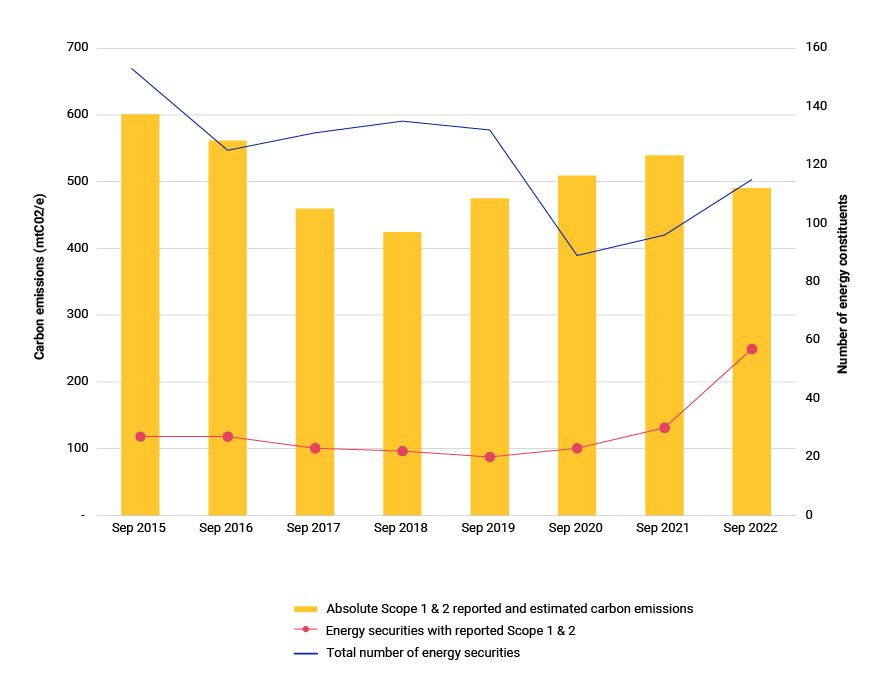
The aggregated absolute carbon emissions and number of constituents are based on annual snapshots from 2015 to 2022 for Scope 1 & 2 emissions. Carbon emissions is subject to constituent eligibility. Data as of July 29, 2022.
To explore whether a potential carbon migration exists, we look into initial public offerings (IPOs), delistings and the share of investable energy companies in public markets to gain insight into the drivers of the lower energy sector carbon footprint in U.S. public markets.
To IPO or not to IPO: Evolving private exit strategies
The private-to-public movement has considerably slowed across all sectors over the last two decades, as measured by both deal count and proceed shares.6 One notable factor that may have contributed to the weakening IPO trend is the robust growth of private capital markets. These markets have provided private companies with alternative sources of financing outside of public markets, and they have also widened the scope of private investment opportunities for private-equity investors.
Private energy investment exits clearly stood out in the shift from the IPO route to the private path. The energy sector's share of all IPOs has been trending downward over the last 10 years, falling to less than 3% of deal count and less than 5% of proceeds in 2021, based on a seven-year rolling sum (see left chart below). Within the energy sector and compared to other exit options, IPOs appear to have lost steam as an exit strategy, accounting for only 4.8% of the sector's deal count and 12% of the sector's private investment exit proceeds over the same period. This contrasts to the energy IPO momentum seen in 2012 that reversed after 2014, demonstrating a shift in energy private exit strategies that might have been impacted by the unfavorable energy-price environment (below right).
Energy sector share of IPOs
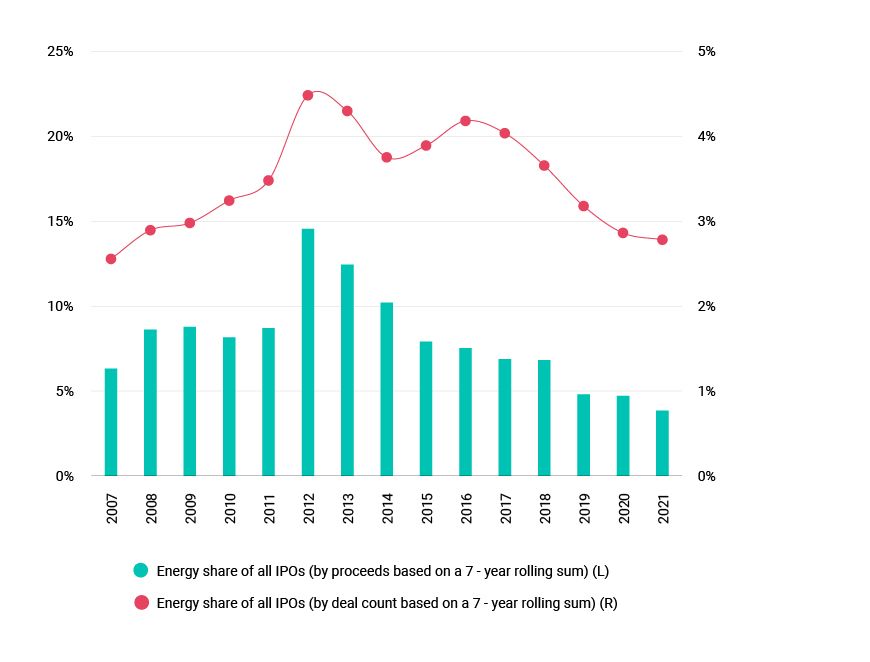
Private energy investment exits
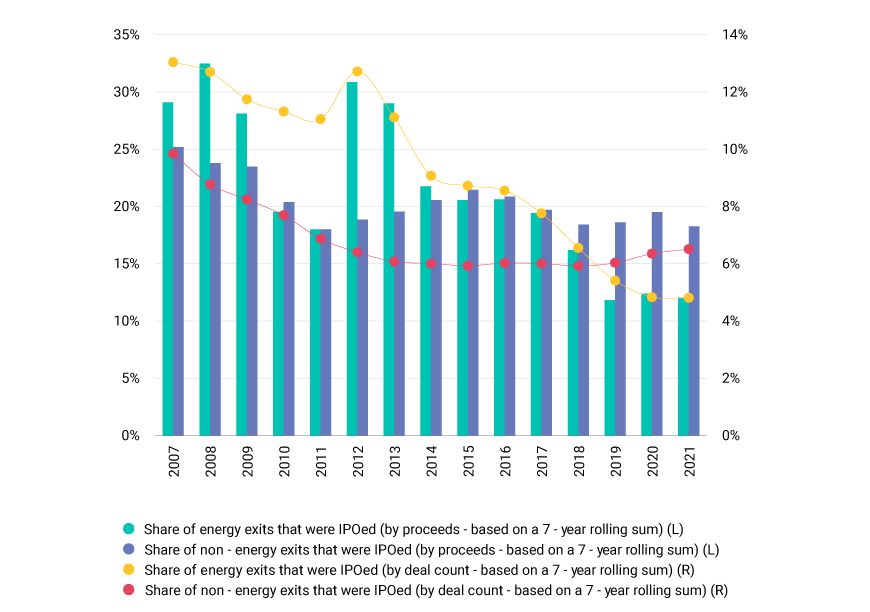
The analysis is based on aggregated total proceeds of ~USD 1.8 trillion from 67,268 private exited holdings in U.S. companies. Annual percentages are based on 7-year rolling sums. Data as of Q2 2022. In Burgiss Transparency Data, an IPO refers to a deal which is exited through the sale or distribution of its equity securities during or after an IPO, direct listing, or Special Purpose Acquisition Company merger or acquisition (SPAC M&A). Source: Burgiss.
Public equity market: Energy investability and delisting
Across 458 delisting events7 in U.S. public markets between 2016 and 2021, 87 related to securities in the energy sector (as detailed below). More than 75% of these energy sector delisting events were due to financial difficulties that may have resulted in eventual bankruptcy,8 and approximately 67% of the delisted companies tracked received private-equity financing.9 This is consistent with the "high risk, high reward" profile of the sector, particularly relating to oil and gas exploration, which does not automatically guarantee drilling success and could lead to significant financial losses, as well as headwinds from energy prices.
US energy-sector delistings
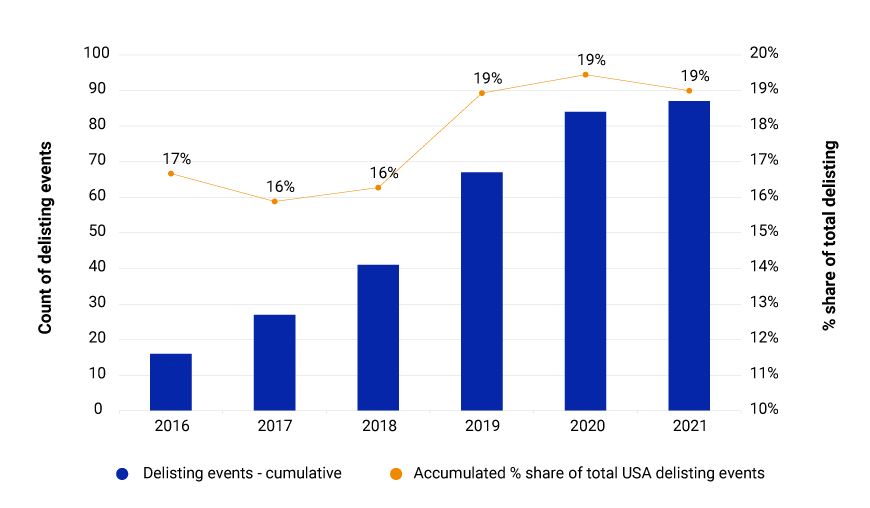
The years represent the accumulated recorded delisting events and the accumulated share of events relative to all U.S. delisting events from 2016 to 2021 for MSCI and non-MSCI index constituents.
In addition to the energy sector's significant share of delisting events and its slowing IPO trend, the number of investable large-, mid- and small-cap energy securities in the U.S. has also declined. The drop was most evident in 2020 and 2021, with the MSCI USA IMI Index totalling 89 and 96 energy constituents (or 3.8% and 3.9% of total constituents) in the respective years, which was below the 2007-2019 annual average of 153 securities or a 6.2% share (as shown below).
Energy-sector constituents of the MSCI USA IMI Index
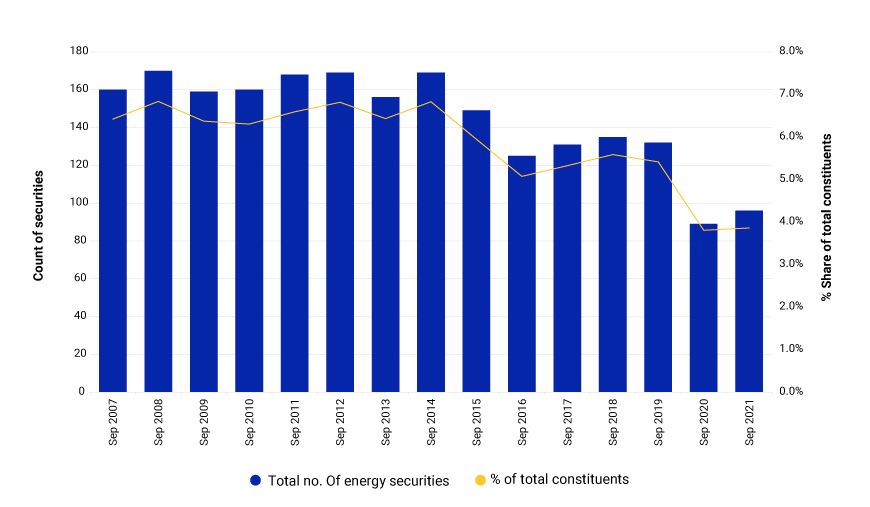
The total number of energy sector constituents are based on annual snapshots from 2007 to 2021, taken as of the start of September of each year to coincide with the Quarterly Index Review in August.
Running out of gas?
Amid the forthcoming regulatory scrutiny in public markets, the decline of energy IPOs may contribute to the possible accumulation of underreported carbon emissions in private markets. A decreasing number of MSCI index-eligible energy securities and the sector's notable share of recent delisting events also appear to underscore concerns regarding a potential carbon migration out of U.S. public markets. These trends, primarily driven by energy price impacts and other financial factors, highlight the urgency for greater transparency across both public and private markets. This may be particularly vital for energy companies whose carbon emissions are financially material to investors.
The authors would like to thank Mehdi Alighanbari for his contribution to this blog post.
Further Reading
Subscribe todayto have insights delivered to your inbox.
1 GICS® is the industry-classification standard jointly developed by MSCI and S&P Global Market Intelligence.2 In public and private markets. Carbon footprint data from MSCI ESG Research and Burgiss.3 Any reference to the measurement of the energy sector’s carbon footprint in this blog refers to the total carbon emissions of U.S.-listed companies that are classified as belonging to the energy sector. This does not pertain to the carbon footprint of the energy sector or the total carbon emissions from all U.S. facilities and operations.4 Reported and estimated emissions.5 As measured using the total carbon emissions of the energy sector.6 Deal count refers to the number of private investments in a given company, while proceeds are the value of capital received by the private fund from liquidating a private investment holding.7 Delisting refers to the removal of listing on the primary exchange covered by MSCI but maintain another listing or start a new listing on a different exchange. MSCI tracks corporate actions of securities that are within the MSCI universe, including but not limited to the MSCI Global Investable Market Index universe.8 Companies that file for bankruptcy are separately tracked by MSCI.9 Burgiss Transparency Data.
The content of this page is for informational purposes only and is intended for institutional professionals with the analytical resources and tools necessary to interpret any performance information. Nothing herein is intended to recommend any product, tool or service. For all references to laws, rules or regulations, please note that the information is provided “as is” and does not constitute legal advice or any binding interpretation. Any approach to comply with regulatory or policy initiatives should be discussed with your own legal counsel and/or the relevant competent authority, as needed.

